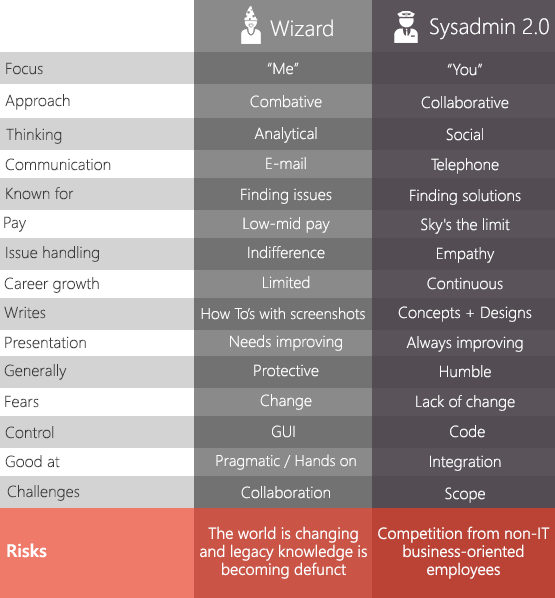Introduction
When tasked with a major technology transformation, you will likely need to assess the team capability. Often, the assessment will immediately reveal differences in the team capabilities, and it becomes essential to understand the make-up of the team, how they operate culturally, and how they deliver change within their organisation (and most importantly, not make assumptions!).
The the multi-generational tech workforce presents some challenges, which I will cover in a future post. For now though, focusing on the older technical staff I have observed from on-site one-to-one assessments, reviewing CVs, and interviewing candidates, some big and obvious things, started to appear:

Many have been in their companies for 10-20 years or more.
Many have a small number of industry qualifications but, having not moved jobs frequently, they have not kept up-to-date with certifications.
They have been critical to business growth, but due to either personal choice or capability they have decided to remain technical and hands-on.
Effectively, they have been on the IT production line for years and have witnessed and been part of major organisational changes, but nothing has changed for them personally.
Many are very capable and have helped deliver significant projects that have been beneficial to the business.
But, whilst many are capable, they may not have been exposed to the new environments, soft skills, or technology that would ensure personal career security.
In addition, being middle-aged, they have far more responsibilities than they did when they first started in IT. They think they no longer have the time to learn.
All this indicates that there is a lot of latent talent out there.
Due to their significant contribution to industry over the past 20+ years, combined with their age and wisdom I refer to these people – in a positive manner – as ‘Wizards’ (especially fitting, as being a “technical wizard” was certainly a phrase that was used a lot in legacy tech, though I don’t often hear it now).
The net result is that these ‘Wizards’ could be facing job insecurity, yet they have a lot of potential to grow and ensure they are more secure in the IT job market. To do this, they will need to learn new skills to complement their current abilities.
I recently listened to a webinar where millennials were compared to baby-boomers and middle-aged technology staff, where one of the main benefits of employing a younger team member was said to be their communication and social skills. It made me think, surely the Wizards can be taught these skills? They’ve already mastered so many skills in the past.
Wizards
Before going into this new combined technical role, first it’s worth looking back at legacy/on-prem technical staff:
According to Wikipedia:
“A system administrator, or sysadmin, is a person who is responsible for the upkeep, configuration, and reliable operation of computer systems; especially multi-user computers, such as servers.
The system administrator seeks to ensure that the uptime, performance, resources, and security of the computers he or she manages meet the needs of the users, without exceeding the budget.
To meet these needs, a system administrator may acquire, install, or upgrade computer components and software; provide routine automation; maintain security policies; troubleshoot; train or supervise staff; or offer technical support for projects”.
Due to the vast responsibility and company-wide responsibility and impact Sysadmins had, they were involved in every IT decision and often had a major controlling stake in change. As software was often shipped by the vendors with some faults, they needed to look cynically at every change before implementing updates. As a result, as an industry, we grew and praised critical ‘cynical thought’ processes – and for good reason, it usually protected the business!
Sysadmin 2.0
Combining new communication/social with current technology skills the “Sysadmin 2.0” is born – someone who is more collaborative than analytical and who can communicate effectively to the team and business. I have summarised these differences here, with the disclaimer of not seeking to tar people with the same brush, but to highlight potential areas of personal growth and improvement:

Note that on the comms side I’ve used telephone instead of social media, to indicate willingness to pickup the telephone – assuming the new role would be totally fine with social.
Overall, the shift in the industry is that technical staff now need to think less analytically and more collaboratively – in other words, they need to stop thinking like a Systems Administrator, or “Sysadmin”, and more like a Collaborator.
{{cta(‘e4676540-6987-4463-9cc7-8a97cab53472’)}}
Changes in responsibility
Things have changed. In the past, a Sysadmin may help install a system once and then spend the next 3-5 years maintaining and upgrading it manually “by hand” until the next major system upgrade was made available. Add in multiple systems and 24×7 cover and that would equate to more than one FTE position that is required.
Now, if a company has modern systems and services it is like they are using continuous improvement, or “CI”, which negates the need to install, upgrade or maintain systems as often as previously needed. Once installed these IT systems will maintain themselves by making incremental changes on a daily or weekly basis.
It is these small weekly, daily or even hourly self-installing software updates that is really impacting Sysadmins job security (and database administrators, network administrators, web administrators and computer operators) because it means that much smaller updates are being made that are less risky and need less analysis. If a single update does not work it will be regressed and no one is any the wiser.
The end result is technology that “just works”.
With computer systems that are more reliable and updating more frequently the need for a cynical gatekeeper is diminishing.
Summary
Cynical analysis, whilst still an important requirement to protect businesses is no longer the only filter a Technology Professional can use. With the advent of CI and Cloud, they must ride the wave and see technology changes positively; to reach their full potential they must adapt to be both collaborative and have the ability to act as an interpreter between services and the business. For those who cannot see themselves facing and negotiating with the business they will need to embrace the cloud to learn new hands-on skills.
{{cta(’23b74a59-42a2-4a7c-8ded-6111a29634b7′)}}







